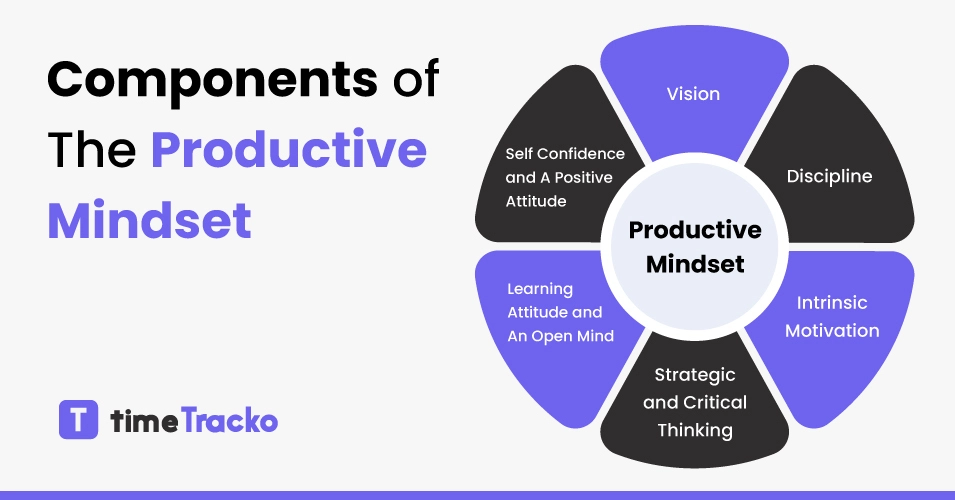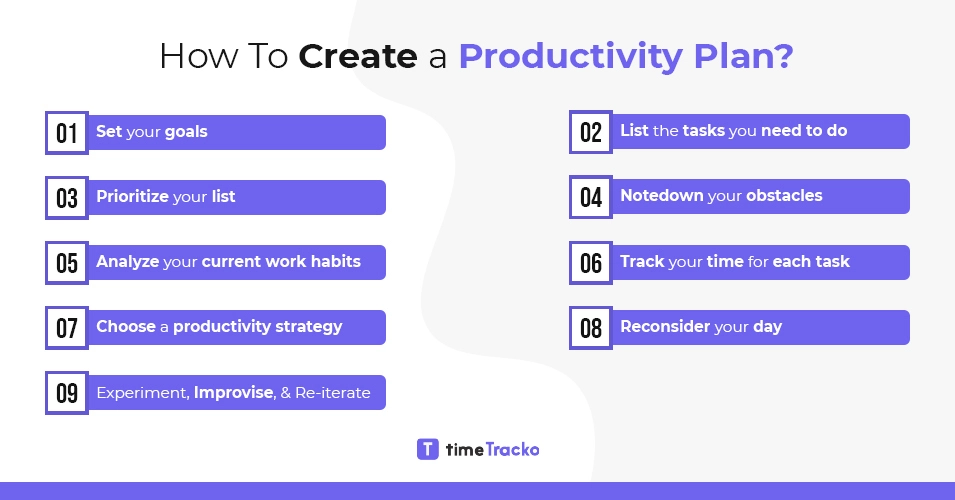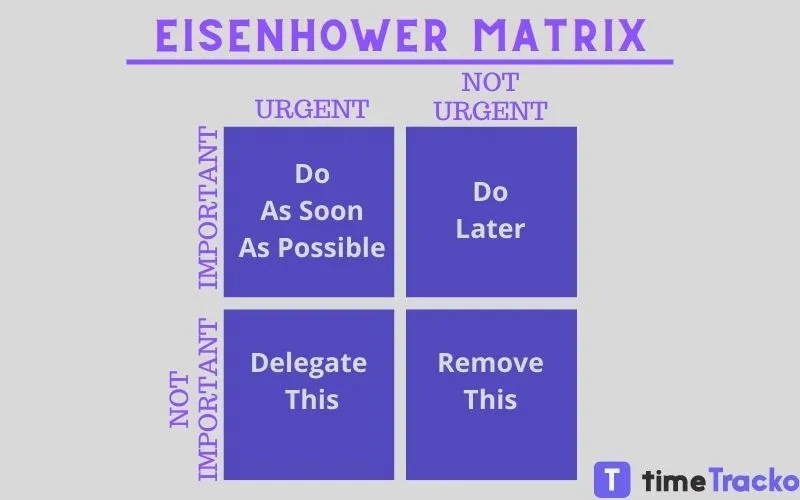Steps to Create an Effective Productivity Plan
Steps to Create an Effective Productivity Plan
Nothing is more irritating than a long day of disorganized activity. It’s even more discouraging when all of your hard work yields no tangible results.
You seek productivity ideas on the internet, but none of them seem to work for you. Do you understand why? That’s because your circumstances, perspective, and working style are unique to you. What works for one person may not have the same outcomes for you.
Creating a productivity strategy might assist you in organizing your time. Regardless of your occupation, making the most of the time you have for work will help you advance in your career. And we mean it. Research has found that the average worker is only productive for two hours and 53 minutes in an eight-hour workday.
Implementing productivity planning is a vital skill that you may gain by studying what to include. In this post, we will define productivity planning, explain why it is essential, and give specific methods for developing a productivity plan.
How To Boost Your Productivity?
There are multiple ways to boost your productivity. You can make a proper plan for a day or year to manage your work time and be productive. Here are some tips that you can use to boost your productivity:
- Not doing multiple tasks at a time
We try to complete multiple tasks at the same time. Rather than completing tasks on time, it will generate more confusion and decrease the productivity rate. Instead of doing multiple tasks, we can focus on one task at a time and complete it on time.
- Planning a particular time of work
Create a proper schedule on when to work. Set proper timing to perform any tasks. Making a proper plan for a particular time of work will also help you to increase your productivity.
- Taking frequent breaks
You have to take breaks in between your work. Working continuously for 6-8 hours will not help to increase your productivity. It would rather get decreased. Take a break of 5-10 minutes in an hour so that your mind can also get rest from continuous work and increase your focus, creativity, and productivity.
- Completing tasks on time
Every task has a fixed deadline. Each task is equally important to do but there may be some tasks that you need to complete in a few periods of time. You have to make sure that every task needs is completed on time.
How To Develop A Productive Mindset?
The first step is to recognize that being productive does not indicate being overworked. You may find that despite working long hours, you haven’t done anything.
You are productive when you make the best use of your time and energy. This work prioritizes quality above quantity.

The productivity mindset is composed of many components:
- Vision
Knowing what your end goals are means you have a clear vision of what you want.
- Discipline
Discipline helps you stay focused on your goals, fight through challenges, and reach your goals by pushing yourself further than you ever thought possible.
- Intrinsic Motivation
Inspirational quotes aren’t going to carry us far, but intrinsic motivation will. An article in Psychology Today explained, “the intrinsic motivation is like a wellspring that never ends. The motivation drives behavior from within.”
- Strategic and Critical Thinking
You should approach situations objectively, rationally, and from different perspectives.
- Learning Attitude and an Open Mind
Open-mindedness means being willing to consider, entertain, and implement new and diverse ideas. These qualities will improve your work, as well as yourself.
The more you practice, the more effective you become, and as a result, the more productive you become.
- Self-Confidence and a Positive Attitude
You must encourage yourself that you are capable of doing all that has to be done and that you can do it very effectively.
What Is A Productivity Plan And Why Do You Need One?
The name itself is a definition of a productivity plan. It is a strategy for increasing your productivity by focusing on the activities that are important to you and your goals.
You can’t just download a blueprint from a self-improvement expert and follow it to the letter. Given your personality and environment, you must devise a strategy to attain your goal.
You may include your objectives, habits you want to acquire, tasks you want to achieve, and priorities in your productivity plan.
A productivity strategy guarantees that you devote appropriate time to the most key tasks, limit distractions, and accomplish more!
It is important to make a productivity plan as it can help you to:
- Organize your assignments,
- identify between critical and insignificant chores,
- improve your decision-making skills,
- match your long-term and short-term goals.
It is the finest solution to inactivity, reminding you of what you need to focus on and getting you closer to your objectives.
Learn more: Skills Needed to Work From Home Employees💻🛠️
Who Could Benefit From A Productivity Plan?
If you don’t feel like you have enough time to complete all you want to do, it’s time to assess your time management abilities.
Nobody is born knowing how to manage their time well, so it’s acceptable if you believe you’re poor at it. However, everyone can learn to increase their productivity and do more!
While productivity plans are advantageous, not every team member will feel it necessary to prepare one. There are persons whose work flourishes in the middle of complete chaos. Confusion, for these folks, creates the best, most imaginative solutions and the strongest waves of motivation.
However, there is one major drawback: people who like that are typically few. Disorganization, for the most part, may be detrimental to your team and make you feel horrible on a personal level.
So, in reality, creating an excellent productivity strategy may help anybody in a company. And so can the entire corporation. We’ve listed many organizational and individual productivity plans that can help with time management in the sections below.
Read More: Factors Affecting Employee Engagement🧑🏼💼💼
How To Create A Productivity Plan?
So you know what a productivity plan is and why it’s beneficial, but how do you create one? It requires more than setting objectives and organizing daily duties.

Several factors might impact your productivity, and a solid productivity strategy resolves all of them through the steps shown below.
Step 1: Set Your Goals
Begin by outlining the activities that demand the most attention. You can include tasks that assist your professional goals or objectives in addition to your important daily obligations. Then, divide the list into primary emphasis areas.
Sort them into categories that make sense to you, such as project-specific activities, short- and long-term objectives, and administrative duties. You may make transitioning from one activity to the next easier by grouping comparable jobs.
Step 2: List The Tasks You Need To Do
Make a list of all the tasks that you need to do. Plan tasks for a day, a week, or for a year about the tasks. Then, make a list of everything you need to accomplish to come closer to your goals.
Include any additional responsibilities you have. This may involve paying payments or walking the dog if you work from home. List all the demands on your time as they come to mind – you’ll prioritize them later.
Step 3: Prioritize Your List
After you make the list of the tasks that you need to do, set priority on which task is more important and needs to complete first. If any of the deadlines are near, then you can make them your priority.
You can also use Eisenhower Matrix to organize your task. It is based on two questions:
- Is it an urgent task?
- Is it an important task?

Step 4: Note Down Your Obstacles
After you make the list by your priority, list down the obstacles that may arise during the task. Make a list of any obstacles, no matter how big or minor.
Here are a couple of such examples:
- Inadequate motivation
- Distractions
- Laziness
- Responsibilities and a lack of time
Be truthful to yourself when you create this list. Even if no one is looking, admitting your flaws is unpleasant. As a result, your mind will feel compelled to think up explanations to justify your bad behavior.
Check to see if you’re not lying to yourself about your bad behaviors.
Learn More: Effects Of Working in an Unhealthy Environment🤦🏾♀️🤧
Step 5: Analyze Your Current Work Habits
Next, record what you do throughout a regular work week. Make certain questions and create a report to analyze your work.
- When do you start and when do you leave work?
- What do you do initially, and how long do you do it for?
- How frequently do you take breaks?
- How much time do you spend on non-work-related activities such as social media?
Understanding what is taking up your time and if it is worthy of your attention might help you better manage your time. It might also highlight any barriers you may have missed.
Step 6: Track Your Time For Each Task
The next step of the effective productivity plan is to note down the time you have taken or will take to do the task. Managing time is the process of dividing your time according to the importance of the task.
You can also check the deadlines for each task and manage the time accordingly. You can have a plan on how much time you have and how much time you need to complete the task.
If you have deadlines coming near, you need to complete that first. Also, you need to figure out how much time each task requires to complete and how much time you have in total.
You also need to take frequent breaks while doing the tasks. It will keep your mind fresh, allowing you to operate more effectively for longer periods.
Working constantly might raise your risk of burnout, which can impede progress on your projects. A 10-minute break can make a significant impact.
Step 7: Choose A Productivity Strategy
Analysis of how you spend your time can help you identify areas that require more attention as well as places where you spend too much time. Your schedule should take advantage of your peak concentration hours while also leaving room for unexpected assignments.
Staying realistic about your goals and talents might assist you in developing a well-organized and productive plan.
Here are some popular productivity strategies that you might want to try out:
i. Anthony Trollope’s Strategy
Trollope is a creative English novelist who believes that writing, especially novels, can take a long time and get depressing. Similar to writing novels, some tasks are larger and take more time to complete which also can be frustrating.
Trollope found a solution: instead of assessing his progress in terms of chapter completion, he measured it in 15-minute intervals. It gave him a sense of success and an instant reward.
So, by monitoring your development regularly, you’ll have a stronger sense of accomplishment and will be more encouraged to keep up your performance.
ii. The Ivy Lee Method
The Ivy Lee method is a 100-year-old concept for increasing workplace productivity. You should focus on one task at a time, progressing from most essential to least important, until you’ve completed your entire list, according to the Ivy Lee method.
Any outstanding business should be added to the list of six activities for the next day. The Ivy Lee method is easy:
- Make a list of the six tasks you need to perform tomorrow.
- Sort them according to their relative importance.
- Complete the first task on the list the next day. Then on to the second.
- Finish the remaining of the list. If you don’t finish it, add what’s left to your list for tomorrow.
- Repeat.
iii. The Pareto Principle
This principle is also called as 80/20 rule as it maintains that 80% of results come from 20% of work.
Here are some instances of how the Pareto Principle might be applied:
- 20% of our actions provide 80% of the results.
- Only 20% of consumers generate 80% of their income.
- 20% of the impacts result in 80% of the circumstances.
Find the important 20% of activities that make a difference for you and focus on them. Our time and energy are finite resources that must be managed carefully.
Step 8: Reconsider Your Day
Once you have enough data on how effective your planning is, you may begin reevaluating the direction or strategy of your plan based on the facts.
For example, you may conclude that you wish to revise a goal or that one of your objectives needs extra time or team members.
Use these findings to constantly enhance your product strategy, and repeat this process anytime fresh data becomes available.
Step 9: Review: Experiment, Improvise And Re-iterate
You will rarely get a huge plan just right the first time you ask. That is why reviews are such an essential part of effective planning. Planning is not a one-time event. It is a continual process that must be evaluated and assessed regularly to assess progress and efficacy.
You will be able to monitor progress during your weekly time management review when your tasks are input into your productivity system. It is also critical to plan regular evaluations for each project to ensure that you and everyone involved are on track. This helps you to discover and repair errors before they cause serious harm to your goals.
Learn More: Free Microsoft Tools to Boost Productivity
FAQs
Why is it important to make productivity planning?
There are a few reasons to make an effective productivity plan. Some of them are:
- You can prepare for the future by creating long-term plans.
- It makes time management more efficient.
- It helps you prioritize tasks.
What Are The Tips For Creating A Productive Plan?
Here are some more ideas to help you develop a successful productivity plan:
- Plan one task at a time.
- Organize your activities into time slots.
- Make frequent planning a habit.
- Understand how the productivity enhancements you desire will impact your success.
- Make use of a planning tool, such as a calendar or spreadsheet.
Conclusion
There are several techniques to increase productivity, but one of the most effective is to develop a productivity strategy. Productivity plans can assist you in organizing your workload and being a more productive employee.
Similarly, you may adopt someone else’s productivity tactics if they match your lifestyle – after all, you could discover some secrets that you can apply on your own.
If done correctly, you can plan your calendar for the full year!

 in Melbourne
in Melbourne 
 Employee Screen Monitoring Software
Employee Screen Monitoring Software App and Website Monitoring Software
App and Website Monitoring Software Time and Attendance Software
Time and Attendance Software Finance
Finance Banking
Banking Healthcare
Healthcare Lawyers
Lawyers Retail & ecommerce
Retail & ecommerce Knowledge base
Knowledge base Blogs
Blogs Installation Guide
Installation Guide FAQs
FAQs About
About Media Kit
Media Kit Contact us
Contact us